Lobo | |
|---|---|
| Municipality of Lobo | |
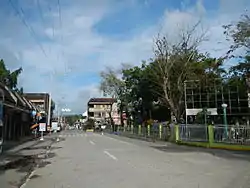 Downtown | |
 Flag  Seal | |
| Etymology: Wolf | |
| Nickname: | |
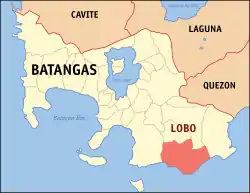 Map of Batangas with Lobo highlighted | |
OpenStreetMap | |
.svg.png.webp) Lobo Location within the Philippines | |
| Coordinates: 13°39′N 121°15′E / 13.65°N 121.25°E | |
| Country | Philippines |
| Region | Calabarzon |
| Province | Batangas |
| District | 2nd district |
| Founded | September 27, 1871 |
| Barangays | 26 (see Barangays) |
| Government | |
| • Type | Sangguniang Bayan |
| • Mayor | Lota L. Manalo |
| • Vice Mayor | Gaudioso R. Manalo |
| • Representative | Gerville Luistro |
| • Municipal Council | Members |
| • Electorate | 27,511 voters (2022) |
| Area | |
| • Total | 175.03 km2 (67.58 sq mi) |
| Elevation | 109 m (358 ft) |
| Highest elevation | 905 m (2,969 ft) |
| Lowest elevation | 0 m (0 ft) |
| Population (2020 census)[4] | |
| • Total | 40,736 |
| • Density | 230/km2 (600/sq mi) |
| • Households | 9,944 |
| Economy | |
| • Income class | 3rd municipal income class |
| • Poverty incidence | 20.52 |
| • Revenue | ₱ 170.5 million (2020) |
| • Assets | ₱ 586.4 million (2020) |
| • Expenditure | ₱ 133 million (2020) |
| • Liabilities | ₱ 259.9 million (2020) |
| Service provider | |
| • Electricity | Batangas 2 Electric Cooperative (BATELEC 2) |
| Time zone | UTC+8 (PST) |
| ZIP code | 4229 |
| PSGC | |
| IDD : area code | +63 (0)43 |
| Native languages | Tagalog |
| Major religion/s | Roman Catholic |
| Feast date | September 23-28 |
| Catholic diocese | Archdiocese of Lipa |
| Patron saint | Saint Michael |
| Website | www.ilovelobo.ph |
Lobo, officially the Municipality of Lobo (Tagalog: Bayan ng Lobo), is a 3rd class municipality in the province of Batangas, Philippines. According to the 2020 census, it has a population of 40,736 people.[4]
Etymology
The name "Lobo" may have come from:
- the Spanish and Tagalog term for "wolf", lobo
- the Lobo River, which flows through Lobo itself and
- the balloon that went into Mt. Banoi.
The town was proclaimed as the "Atis Capital of the Philippines" through Resolution 2011-61 in September 2011.[1]
History
Prior to the arrival of the Spanish colonizers in the Philippines, Lobo was just a wilderness of thick forest with inhabitants scattered and most of the settlers were hunters who roam from place to place seeking for wild animals for food. Some archeologist believed that a small group of Chinese traders during the pre-Spanish occupation have stayed in this place. This belief was based on the remains that were unearthed in a certain hill in Barangay Sawang, which is presumed to be a small Chinese cemetery during the said period due to the kind of kitchen wares that were found beside their graves. The coming of the ten datus in the Philippines in the 13th century had contributed a vital part in this history of this municipality.
History stated that after Datu Puti and his followers purchased the island of Panay and fully establishing a colony in the island, Datu Puti with Datu Balkasusa and Datu Domangsil left Panay and sailed north in search from greener pastures. The group reached Batangas and caused the founding of the first Malayan colony in Luzon. They first settled the eastern and western sides of Pansipit River which are now Lemery and Taal and later on they scattered in the province settling Kumintang which is named in honor of Lakan Kumintang. The most adventurous follower of Lakan Kumintang was Gat Bahaghari and with his family and a handful of followers, they traveled south to Rosario and trailing along Rosario-Lobo River, they reached the “Wawa of Lobo” (now Fabrica) which his followers named it Bahaghari in honor of him. Attracted by the panoramic view and soil fertility of this place, Gat Bahaghari and his followers decided to establish a permanent settlement in this area.
Some followers of Gat Bahaghari thinked if they want to easily detect the coming of the pirates that may harass their peaceful living, they built their houses on the top of a hill overlooking the sea which is now the Municipal Cemetery of Lobo. Beneath this hill on the west side is low land treasured with “sumasagitsit” or running tiny streams of water which they utilized to irrigate their farms. With the help of the streams, their farms became very productive that enabled them to transport their excess products to their bountiful harvests, they replied that they came from sumasagitsit. The term sumasagitsit was later on changed to Masagitsit until it was changed as Barangay Masaguitsit.
The period of the Spanish colonization of the archipelago brought many changes in the life situations in this place. Construction of bigger and stronger houses and other buildings were introduced in the country, and Lobo, being so rich in raw materials for construction purposes, attracted many loggers and timberman from other places to immigrate in. Residents of the places that were fully occupied were the lowland northwest of Lobo River which is now Poblacion. In 1734, Lobo was already in the map but originally a logging settlement, Lobo was founded on September 27, 1871.[6]
Geography
Lobo is located at 13°39′N 121°15′E / 13.65°N 121.25°E. The town is located near the southern tip of the Batangas province, about 145 kilometres (90 mi) from Manila.
Lobo has white sand beaches and has protected mangrove forests and fish sanctuaries.[7]
According to the Philippine Statistics Authority, the municipality has a land area of 175.03 square kilometres (67.58 sq mi) [8] constituting 5.61% of the 3,119.75-square-kilometre- (1,204.54 sq mi) total area of Batangas.
Barangays
Lobo is politically subdivided into 26 barangays.[9] Each barangay consists of puroks and some have sitios.
According to the 2020 census, the most populated barangay in Lobo is Balibago with 3,454 residents living while the least populated barangay in Lobo is Malalim na Sanog with 306 residents living. Lobo originally had 7 barangays named as Masagitsit (now Masaguitsit), Bignay, Tayuman, Malapad na Parang, Mabilog na Bundok, Malabrigo, and Sabana (non-existent now).
In 1959, the sitio of Biga in Barangay Tayuman was converted into a barangay.
| PSGC | Barangay | Population | ±% p.a. | |||
|---|---|---|---|---|---|---|
| 2020[4] | 2010[10] | |||||
| 041015001 | Apar | 2.9% | 1,176 | 959 | 2.06% | |
| 041015002 | Balatbat | 5.9% | 2,400 | 2,137 | 1.17% | |
| 041015003 | Balibago | 8.5% | 3,454 | 2,967 | 1.53% | |
| 041015004 | Banalo | 6.2% | 2,515 | 2,195 | 1.37% | |
| 041015005 | Biga | 5.0% | 2,030 | 1,782 | 1.31% | |
| 041015006 | Bignay | 1.2% | 501 | 432 | 1.49% | |
| 041015007 | Calo | 2.3% | 918 | 913 | 0.05% | |
| 041015008 | Calumpit | 2.0% | 819 | 734 | 1.10% | |
| 041015009 | Fabrica | 5.0% | 2,056 | 1,742 | 1.67% | |
| 041015010 | Jaybanga | 4.6% | 1,873 | 1,652 | 1.26% | |
| 041015011 | Lagadlarin | 5.1% | 2,086 | 1,853 | 1.19% | |
| 041015012 | Mabilog na Bundok | 4.3% | 1,740 | 1,675 | 0.38% | |
| 041015013 | Malabrigo | 4.3% | 1,744 | 1,546 | 1.21% | |
| 041015014 | Malalim na Sanog | 0.8% | 306 | 205 | 4.09% | |
| 041015015 | Malapad na Parang | 3.6% | 1,461 | 1,455 | 0.04% | |
| 041015016 | Masaguitsit | 3.4% | 1,377 | 1,234 | 1.10% | |
| 041015017 | Nagtalongtong | 5.1% | 2,066 | 1,994 | 0.36% | |
| 041015018 | Nagtoctoc | 1.5% | 617 | 591 | 0.43% | |
| 041015019 | Olo‑olo | 3.5% | 1,406 | 1,377 | 0.21% | |
| 041015020 | Pinaghawanan | 1.2% | 488 | 419 | 1.54% | |
| 041015021 | San Miguel | 2.0% | 802 | 732 | 0.92% | |
| 041015022 | San Nicolas | 2.3% | 939 | 763 | 2.10% | |
| 041015023 | Sawang | 5.2% | 2,138 | 1,831 | 1.56% | |
| 041015024 | Soloc | 5.5% | 2,223 | 1,801 | 2.13% | |
| 041015025 | Tayuman | 4.1% | 1,652 | 1,409 | 1.60% | |
| 041015026 | Poblacion | 6.7% | 2,717 | 2,672 | 0.17% | |
| Total | 40,736 | 37,070 | 0.95% | |||
Climate
| Climate data for Lobo, Batangas | |||||||||||||
|---|---|---|---|---|---|---|---|---|---|---|---|---|---|
| Month | Jan | Feb | Mar | Apr | May | Jun | Jul | Aug | Sep | Oct | Nov | Dec | Year |
| Mean daily maximum °C (°F) | 27 (81) |
28 (82) |
30 (86) |
32 (90) |
31 (88) |
30 (86) |
29 (84) |
29 (84) |
29 (84) |
29 (84) |
28 (82) |
27 (81) |
29 (84) |
| Mean daily minimum °C (°F) | 21 (70) |
20 (68) |
21 (70) |
22 (72) |
24 (75) |
24 (75) |
24 (75) |
24 (75) |
24 (75) |
23 (73) |
22 (72) |
22 (72) |
23 (73) |
| Average precipitation mm (inches) | 52 (2.0) |
35 (1.4) |
27 (1.1) |
27 (1.1) |
82 (3.2) |
124 (4.9) |
163 (6.4) |
144 (5.7) |
145 (5.7) |
141 (5.6) |
100 (3.9) |
102 (4.0) |
1,142 (45) |
| Average rainy days | 12.0 | 8.1 | 8.8 | 9.7 | 17.9 | 22.6 | 26.2 | 24.5 | 24.6 | 22.0 | 16.7 | 14.9 | 208 |
| Source: Meteoblue[11] | |||||||||||||
Demographics
| Year | Pop. | ±% p.a. |
|---|---|---|
| 1903 | 5,781 | — |
| 1918 | 6,999 | +1.28% |
| 1939 | 8,964 | +1.19% |
| 1948 | 11,711 | +3.01% |
| 1960 | 15,197 | +2.19% |
| 1970 | 19,376 | +2.46% |
| 1975 | 22,092 | +2.67% |
| 1980 | 24,333 | +1.95% |
| 1990 | 26,881 | +1.00% |
| 1995 | 31,849 | +3.23% |
| 2000 | 33,909 | +1.35% |
| 2007 | 37,798 | +1.51% |
| 2010 | 37,070 | −0.71% |
| 2015 | 41,504 | +2.18% |
| 2020 | 40,736 | −0.37% |
| Source: Philippine Statistics Authority[12][10][13][14] | ||
In the 2020 census, Lobo had a population of 40,736.[4] The population density was 230 inhabitants per square kilometre (600/sq mi).
Economy
Government

Elected officials
Lota L. Manalo and Jurly R. Manalo are the current mayor and vice mayor, respectively.[2]
The Municipal Councilors are:
- Geronimo Alfiler
- Angelito Abiera
- Michael Cueto
- Jan-Michael Anyayahan
- Victoriano Dueñas
- Mark Ernani Tiu
- Amador Ambrocio Sulit
- Leslee Aguilar
Fish sanctuaries

Lobo has several fish sanctuaries:[22][23]
- Lobo Mangrove Conservation Area
- Sawang and Olo-Olo Fish Sanctuary and Refuge Area
- Malabrigo Fish Sanctuary and Refuge Area
- Biga Fish Sanctuary and Refuge Area
Gallery
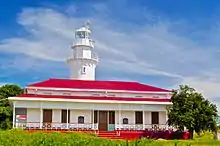 Malabrigo Point Lighthouse
Malabrigo Point Lighthouse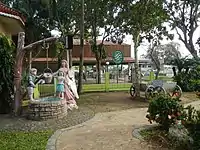 Park
Park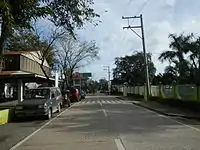 Downtown Lobo
Downtown Lobo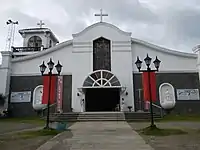 Saint Michael the Archangel Parish Church
Saint Michael the Archangel Parish Church
References
- 1 2 "Government boosts atis production in Lobo". The Philippine Star. 29 November 2015. Retrieved 30 November 2016.
- 1 2 Municipality of Lobo | (DILG)
- ↑ "2015 Census of Population, Report No. 3 – Population, Land Area, and Population Density" (PDF). Philippine Statistics Authority. Quezon City, Philippines. August 2016. ISSN 0117-1453. Archived (PDF) from the original on May 25, 2021. Retrieved July 16, 2021.
- 1 2 3 4 Census of Population (2020). "Region IV-A (Calabarzon)". Total Population by Province, City, Municipality and Barangay. Philippine Statistics Authority. Retrieved 8 July 2021.
- ↑ "PSA Releases the 2018 Municipal and City Level Poverty Estimates". Philippine Statistics Authority. 15 December 2021. Retrieved 22 January 2022.
- ↑ "History". Official Website of the Municipality of Lobo Batangas.
- ↑ "Mining the white gold". BusinessMirror. 2 December 2018. Retrieved 2 April 2023.
- ↑ "Province: Batangas". PSGC Interactive. Quezon City, Philippines: Philippine Statistics Authority. Retrieved 12 November 2016.
- ↑ "Municipal: Lobo, Batangas". PSGC Interactive. Quezon City, Philippines: Philippine Statistics Authority. Retrieved 8 January 2016.
- 1 2 Census of Population and Housing (2010). "Region IV-A (Calabarzon)" (PDF). Total Population by Province, City, Municipality and Barangay. National Statistics Office. Retrieved 29 June 2016.
- ↑ "Lobo: Average Temperatures and Rainfall". Meteoblue. Retrieved 5 May 2020.
- ↑ Census of Population (2015). "Region IV-A (Calabarzon)". Total Population by Province, City, Municipality and Barangay. Philippine Statistics Authority. Retrieved 20 June 2016.
- ↑ Censuses of Population (1903–2007). "Region IV-A (Calabarzon)". Table 1. Population Enumerated in Various Censuses by Province/Highly Urbanized City: 1903 to 2007. National Statistics Office.
{{cite encyclopedia}}: CS1 maint: numeric names: authors list (link) - ↑ "Province of Batangas". Municipality Population Data. Local Water Utilities Administration Research Division. Retrieved 17 December 2016.
- ↑ "Poverty incidence (PI):". Philippine Statistics Authority. Retrieved December 28, 2020.
- ↑ "Estimation of Local Poverty in the Philippines" (PDF). Philippine Statistics Authority. 29 November 2005.
- ↑ "2003 City and Municipal Level Poverty Estimates" (PDF). Philippine Statistics Authority. 23 March 2009.
- ↑ "City and Municipal Level Poverty Estimates; 2006 and 2009" (PDF). Philippine Statistics Authority. 3 August 2012.
- ↑ "2012 Municipal and City Level Poverty Estimates" (PDF). Philippine Statistics Authority. 31 May 2016.
- ↑ "Municipal and City Level Small Area Poverty Estimates; 2009, 2012 and 2015". Philippine Statistics Authority. 10 July 2019.
- ↑ "PSA Releases the 2018 Municipal and City Level Poverty Estimates". Philippine Statistics Authority. 15 December 2021. Retrieved 22 January 2022.
- ↑ Casayuran, Mario; Terrazola, Vanne Elaine (22 April 2018). "Locals realize what the real 'gold' is in Lobo, Batangas". Manila Bulletin. Retrieved 2 April 2023.
- ↑ Gonzales, Yuji Vincent (9 June 2015). "Environmental group opposes large-scale Batangas mining project". INQUIRER.net. Retrieved 2 April 2023.